#286 Latest Comet Hyakutake images: March 31, 1996
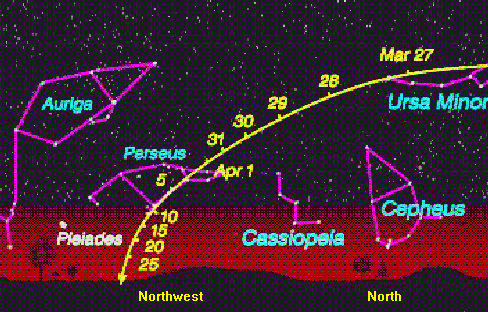
“During April Comet Hyakutake heads in toward the Sun after passing the Earth. At this time the comet's orbit places it north of the Earth. Remaining visible in the northern sky as it nears the Sun, it will set progressively earlier in the evening. Early in April, the Moon's glow will diminish viewing of the comet's tail - except during the lunar eclipse on April 3rd! As the comet recedes from the Earth it will appear dimmer even though it is getting intrinsically brighter as it nears the Sun. In late April the intrinsic brightening effect will "win" and the comet will again appear to brighten - possibly getting even brighter than it was last week. At this point the comet will appear near sunset low on the northwestern horizon (see above). So far Comet Hyakutake has exceeded most expectations in brightness and length of tail. If you haven't been impressed by Hyakutake, you probably haven't seen it from a dark location! Latest Comet Hyakutake images: JPL, Fayetteville Observer-Times, NASA's Night of the Comet, ICSTARS, Crni Vrh Obs., Cent. Mich U."
Copyright: Public domain
#287 Latest Comet Hyakutake images: April 01, 1996
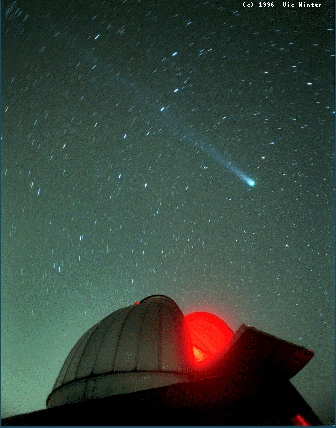
“In one of the more spectacular pictures yet taken, Comet Hyakutake is shown here on March 26 high in the dark Missouri sky. In the foreground is Elmcrest Observatory complete with a dim red light glowing inside the dome. The stars in the background moved slightly during the exposure causing them to appear as streaks instead of points of light. Nevertheless, the constellation of Ursa Major - including the Big Dipper - is visible. Can you spot it? (Hint: Hyakutake's tail flows through the Dipper's handle.) Photographs with both recognizable foreground and background objects visible can be quite striking as they add angular perspective and contrast to the outworldly and unfamiliar comet. Dare anyone try to compete with city lights and capture the Eiffel Tower or the New York skyline in front of the comet? Latest Comet Hyakutake images: APOD Hyakutake Archive, JPL, Fayetteville Observer-Times, NASA's Night of the Comet, ICSTARS, Jerry Lodriguss, ScienceWeb, Crni Vrh Obs., Cent. Mich U."
Copyright: Vic
WinterICSTARS
#288 Latest Comet Hyakutake images: April 02, 1996
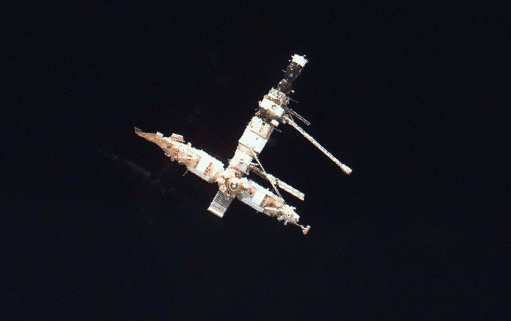
“Imagine flying though space and approaching the Mir space station. The crew of the Space Shuttle Atlantis did just this in a mission that ended only two days ago. Mir, now 10 years old, is equipped for scientific experiments in astronomy, physics, materials, biology and chemistry. The top most module on Mir is an unmanned supply ship used to send food and supplies. The next module with the long boom carries telescopes and essential flight equipment and connects to the core module with living quarters and solar panels. To the left is the Spektr module carrying solar arrays and scientific equipment while on the right is a scientific module that also carries an airlock. The docking module seen at the bottom is the ultimate destination of Atlantis. The STS-76 mission left astronaut Shannon Lucid for a planned five month stay. Four more shuttle flights are currently planned to Mir, keeping a NASA astronaut continuously in space until late 1997. In late 1997, building on this jointly developed understanding and experience, the US and Russia will launch the first modules of the International Space Station. Latest Comet Hyakutake images: APOD Hyakutake Archive, JPL, Fayetteville Observer-Times, NASA's Night of the Comet, ICSTARS, Jerry Lodriguss, ScienceWeb, Crni Vrh Obs., Cent. Mich. U."
Copyright: Public domain
#289 Latest Comet Hyakutake images: April 03, 1996
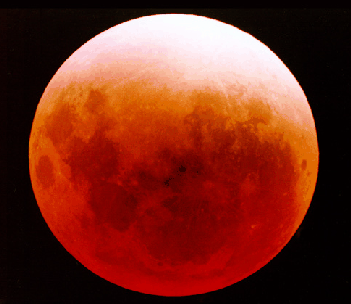
“Tonight's full moon would normally washout the spectacle of Comet Hyakutake's lovely tail, even for those far from light polluted skies. Except that tonight comet observers are in luck - the dance of the planets calls for a total lunar eclipse! Lunar eclipses are caused when the Moon passes through the Earth's shadow. Although dimmed, the eclipsed Moon may not appear completely dark. Sunlight scattered into the Earth's shadow after passing around the planet's edge and through its dusty atmosphere can make the Moon take on dramatic shades of red during totality as demonstrated in the above photo of the November 1993 lunar eclipse. Tonight, totality begins at 6:26 p.m. EST and lasts about an hour and a half. Weather permitting, the eclipse will be visible for all those comet and moon watchers lucky enough to be on the Earth's nightside. Latest Comet Hyakutake images: APOD Hyakutake Archive, JPL, Fayetteville Observer-Times, NASA's Night of the Comet, ICSTARS, Jerry Lodriguss, ScienceWeb, Crni Vrh Obs., Cent. Mich. U."
Copyright: Andy Steere
#290 Latest Comet Hyakutake images: April 04, 1996
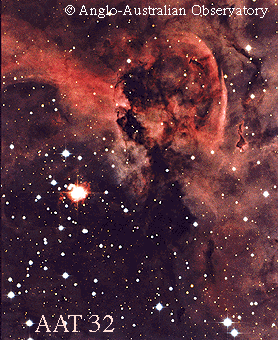
“The dark dusty Keyhole Nebula gets its name from its unusual shape. Designated NGC 3324, the Keyhole Nebula is a smaller region superposed on the bright Eta Carina Nebula. The Eta Carina Nebula is the largest nebula in angular extent on the sky, larger than the famous Orion Nebula, but its southerly location makes it less familiar to Northern Hemisphere skywatchers. The star Eta Carinae itself is extremely variable and has faded in a mere 150 years - formerly one of the brightest in the sky it is now invisible without a telescope. The nebula created by the star's 19th century outburst has been photographed by the Hubble Space Telescope. Latest Comet Hyakutake images: APOD Hyakutake Archive, JPL, Fayetteville Observer-Times, NASA's Night of the Comet, ICSTARS, Jerry Lodriguss, ScienceWeb, Crni Vrh Obs., Cent. Mich. U."
Copyright: Anglo-Australian Telescope
Board
#291 Latest Comet Hyakutake images: April 05, 1996
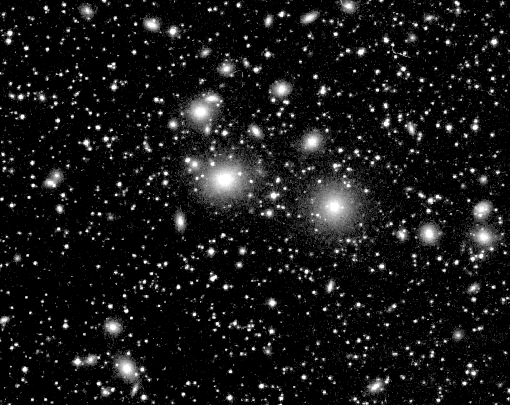
“Here is one of the largest objects that anyone will ever see on the sky. Each of the fuzzy blobs in the above picture is a galaxy, together making up the Perseus Cluster, one of the closest clusters of galaxies. We view the cluster through the foreground of faint stars in our own Milky Way galaxy. It takes light roughly 300 million years to get here from there, so we only see this cluster as it existed during the age of the dinosaurs. Also known as Abell 426, the center of Perseus cluster is a prodigious source of X-ray radiation, and so helps us study how clusters formed and how gas and dark matter interact. The Perseus Cluster of Galaxies is part of the Pisces-Perseus supercluster of galaxies, which spans over 15 degrees and contains over 1000 galaxies. Latest Comet Hyakutake images: APOD Hyakutake Archive, JPL, Fayetteville Observer-Times, NASA's Night of the Comet, ICSTARS, Jerry Lodriguss, ScienceWeb, Crni Vrh Obs., Cent. Mich. U."
Copyright: STScIAAO
#292 Information: April 06, 1996

“In the 1920s, using photographic plates made with the Mt. Wilson Observatory's 100 inch telescope, Edwin Hubble determined the distance to the Andromeda Nebula - decisively demonstrating the existence of other galaxies far beyond the Milky Way. His notations are evident on the plate shown above (the image is a negative with stars appearing as black dots against the white background of space). By intercomparing plates, Hubble searched for "novae", stars which underwent a sudden increase in brightness. He found several on this plate and marked them with an "N". Later he discovered that one was actually a type of variable star known as a cepheid - crossing out the "N" he wrote "Var!" (upper right). Thanks to the work of Harvard astronomer Henrietta Leavitt, cepheids, regularly varying, pulsating stars, could be used as "standard candle" distance indicators. Identifying such a star allowed Hubble to show that Andromeda was not a small cluster of stars and gas within our own galaxy, but a large galaxy in its own right at a substantial distance from the Milky Way. Hubble's discovery is responsible for our modern concept of a Universe filled with galaxies. Information: The Scale of the Universe Debate in April 1996"
Copyright: Public domain
#293 Latest Comet Hyakutake images: April 07, 1996
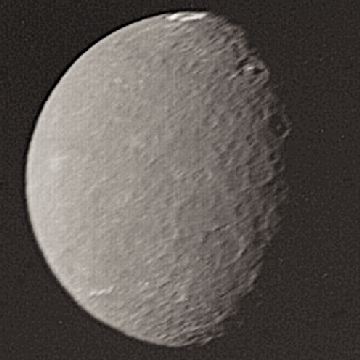
“Why is Umbriel so dark? This dark moon reflects only half the light of other Uranus' moons such as Ariel. And what is that bright ring at the top? Unfortunately, nobody yet knows. These questions presented themselves when Voyager 2 passed this satellite of Uranus in January 1986. Voyager found an old surface with unusually large craters, and determined Umbriel's composition to be about half ice and half rock. Umbriel is the fourth largest and third most distant of Uranus' five large moons. Umbriel was discovered in 1851 by William Lassell. Latest Comet Hyakutake images: APOD Hyakutake Archive, JPL, Fayetteville Observer-Times, NASA's Night of the Comet, ICSTARS, Jerry Lodriguss, ScienceWeb, Crni Vrh Obs., Cent. Mich. U."
Copyright: Public domain
Upvote! Resteem! Comment! As you like it! Thank you for attention!